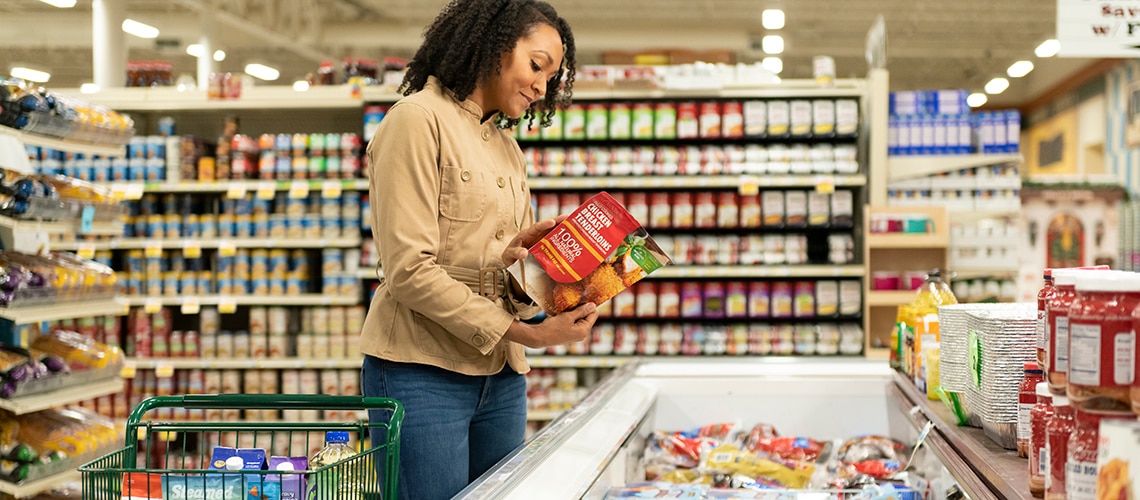
Oct 10, 2025* | Case Study | 8 minute read

Oct 10, 2025* | Case Study | 8 minute read
Modern food packaging in grocery retail is more than just a protective layer—it’s material that shapes the way food is delivered, perceived and trusted by consumers. Packaging encompasses advanced material innovation and design solutions that extend shelf life, support product safety and help address food waste. In today’s competitive retail landscape, packaging is pivotal to the bottom line and overall customer satisfaction.
We are hands-on in this transformative space as a recognized leader in food packaging innovations. Our commitment to collaborating with brands to develop next-generation materials is helping address industry challenges like improving packaging design for recyclability, enhancing product protection and building consumer trust. By focusing on circular materials and cutting-edge barrier technologies, Dow innovation enhances both packaging performance and environmental responsibility.
For a deeper look at the materials reshaping food packaging, explore this overview of food packaging materials. As grocery retail continues to evolve, modern food packaging remains essential to ensuring safe, sustainable and appealing product packaging on every shelf.
Today’s grocery retail landscape is being transformed by innovative packaging solutions that enhance product protection and support brand owners’ sustainability goals. Key advances include flexible packaging materials and paper-based food packaging—each offering unique benefits in terms of shelf life, recyclability and consumer appeal.
Barrier films and sealants play a critical role in maintaining the freshness of food products by protecting them from environmental exposure and reducing spoilage.
We provide barrier, re-sealable and breathable films to help reduce food waste for packaging frozen foods, condiments, confectionery, baked goods, containers, and storage bags.
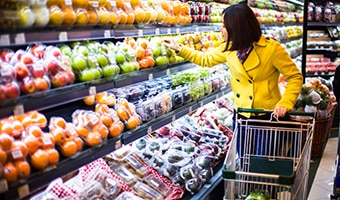 In today’s grocery store, many produce items are stocked and sold the same way they have been since food commerce began, fresh and in bulk. But the way consumers shop has changed greatly. Most shoppers do not go to the store every day, but instead go weekly, bi-weekly or even monthly. The supply chain to get produce to store has also changed. Instead of a short drive from farm to market, produce may travel hundreds or thousands of miles before it ends up in a shopping basket.
In today’s grocery store, many produce items are stocked and sold the same way they have been since food commerce began, fresh and in bulk. But the way consumers shop has changed greatly. Most shoppers do not go to the store every day, but instead go weekly, bi-weekly or even monthly. The supply chain to get produce to store has also changed. Instead of a short drive from farm to market, produce may travel hundreds or thousands of miles before it ends up in a shopping basket.
Dow offers packaging materials intended to extend freshness, protect quality and reduce waste. These packaging solutions use advanced resins and adhesives to support the development of breathable and sustainable packaging for preserving fruits and vegetables throughout distribution.
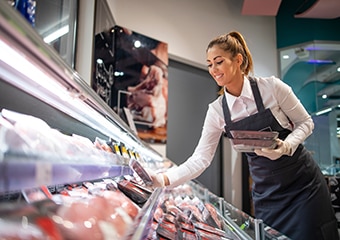 Designing meat packaging with improved oxygen barrier not only protects against spoilage and keeps meats fresher longer, it also protects the meat from graying—a purely cosmetic development that can repel customers, adding to food waste and increased cost for grocers. The plastic film that covers and protects the meat has the same barrier-property enhancements seen in produce applications.
Designing meat packaging with improved oxygen barrier not only protects against spoilage and keeps meats fresher longer, it also protects the meat from graying—a purely cosmetic development that can repel customers, adding to food waste and increased cost for grocers. The plastic film that covers and protects the meat has the same barrier-property enhancements seen in produce applications.
Innovations in the dairy aisle include improved barrier films and sealants that keep oxygen from getting into cheese packages and the ability to keep fats from leaking out and saturating the packaging.
Our meat and cheese packaging materials preserve freshness, improve food safety and help extend shelf life. Using advanced resins and adhesives, we offer durable, tamper-resistant packaging that addresses quality standards of today’s consumers.
Innovative packaging solutions are transforming the quality of snack products. Effective packaging is essential to preserving freshness, preventing staleness in cereal, and maintaining crispness in chips. Premium packaging plays a vital role in ensuring superior product quality.
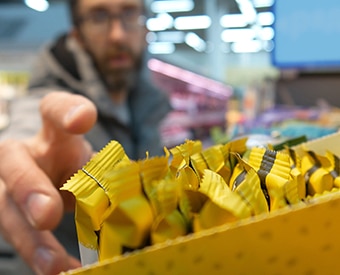 Dow offers sustainable food packaging for processed foods, utilizing flexible materials such as pillow pouches and sachets. Our packaging solutions extend shelf life, provide advanced protective barriers, and deliver visually appealing options that are designed for recyclability for cereals, snacks, and other items. Engineered to comply with modern sustainability standards, these materials are designed to safeguard both product integrity and consumer appeal.
Dow offers sustainable food packaging for processed foods, utilizing flexible materials such as pillow pouches and sachets. Our packaging solutions extend shelf life, provide advanced protective barriers, and deliver visually appealing options that are designed for recyclability for cereals, snacks, and other items. Engineered to comply with modern sustainability standards, these materials are designed to safeguard both product integrity and consumer appeal.
Our resins and adhesives for used in flexible packaging for processed foods offer efficient production, improved shelf life, and strong material integrity, while meeting consumer demand for safe and sustainable packaging.
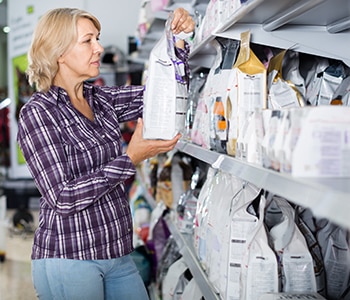 Even staple and bulk items benefit from food packaging innovations.
Even staple and bulk items benefit from food packaging innovations.
Consumer packaging issues are being solved through technological advances, including addressing the weight of canned goods, mitigating the need for specialized product opening tools and how to keep opened dry goods fresher, longer.
Dow’s flexible packaging materials provide high-performance, food-safe options designed for recyclability. Our enhanced resins and films protect products, extend shelf life and improve consumer convenience while supporting efficient, circular packaging solutions.
Our storage bag materials are designed for strength, durability, and sustainability. With advanced resins and adhesives, they help safeguard food from moisture and contaminants. Easy-open flexible, plastic stand-up pouches deliver the same soups, vegetables and sauces that required cans in the past, with less raw materials and shipping weight, saving resources in transportation.
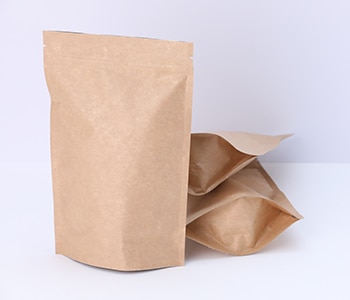 The demand for flexible paper packaging has increased substantially over the years, partially due to increased consumer interest in recyclable paper solutions that still deliver the product quality that they expect.
The demand for flexible paper packaging has increased substantially over the years, partially due to increased consumer interest in recyclable paper solutions that still deliver the product quality that they expect.
Paper-based food packaging solutions offer protection for products using flexible fiber-based packaging and can improve recyclability. This is demonstrated in the Dow barrier coatings for paper products portfolio.
Powered by BLUEWAVE™ Technology, the RHOBARR™ Barrier Coatings for paper portfolio offers ultra-thin, water-based coatings that supports up to 99% fiber recovery during recycling and reduces waste and raw material usage by up to 70% compared to extrusion coated products while providing similar packaging performance.
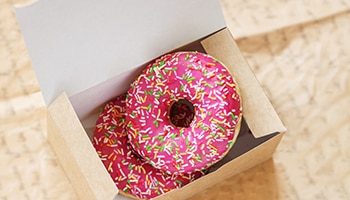 In some areas of the world, the ink on shelf-stable food boxes contains mineral oils that are not intended for consumption, requiring a protective barrier coating to prevent these oils from transferring onto the product. Dow's RHOBARR™ 214 Emulsion blocks this potential transfer and prevents various oils and greases from the product from saturating the packaging fibers. RHOBARR™ Technology offers the additional benefit of being heat sealable, simplifying the packaging construction and manufacturing process.
In some areas of the world, the ink on shelf-stable food boxes contains mineral oils that are not intended for consumption, requiring a protective barrier coating to prevent these oils from transferring onto the product. Dow's RHOBARR™ 214 Emulsion blocks this potential transfer and prevents various oils and greases from the product from saturating the packaging fibers. RHOBARR™ Technology offers the additional benefit of being heat sealable, simplifying the packaging construction and manufacturing process.
Approximately 1 billion metric tons of food goes to waste each year1. Food and packaging waste are major contributors to climate change. According to the UN, “Food loss and waste account for 8-10% of annual global greenhouse gas emissions – nearly five times the total emissions from the aviation sector2.”
Shelf-life is critical to prevent food waste, and packaging plays a critical role in preserving food, reducing waste and increasing the longevity of the products we use every day.
Our approach centers on responsible packaging design that extends shelf life and supports recyclability. For example, vacuum thermoform packs for chicken can extend freshness by two weeks and reduce CO₂ emissions compared to traditional trays. Dow is also advancing bio-based and recycled materials to reduce reliance on fossil fuels.
No packaging, plastic or otherwise, should become waste. Through innovations in materials science and strategic partnerships, we are helping to build more equitable and sustainable food systems. This includes exploring regenerative agriculture and circular economy principles to ensure packaging protects both food and the planet.
Sustainability starts with purposeful design and collaboration. By reimagining packaging, we can feed more people, reduce environmental impact and create a more resilient future.
Innovative packaging solutions offer significant benefits for consumers and retailers by enhancing convenience, protecting freshness and building trust.
Features such as easy-to-open designs and resealable closures allow consumers to access food effortlessly while maintaining its quality after opening. Resealability not only helps reduce waste by extending product freshness, but it also simplifies storage and portability for busy lifestyles. Additionally, transparent packaging enables shoppers to see the product inside, building trust and supporting informed purchasing decisions.
For retailers, these advancements translate into longer shelf-life, reduced spoilage and minimized product returns—all of which contribute to profitability. Eye-catching, informative packaging can also improve shelf appeal and brand differentiation, encouraging repeat purchases.
By addressing both practical needs and consumer preferences, innovative packaging boosts satisfaction, loyalty and overall retail value, making it a win-win for the entire supply chain.
Driven by consumer demand, regulatory standards and the need for operational efficiency, retailers are rapidly adopting innovative packaging solutions with sustainable attributes. Brands are embracing design for recyclability and compostable or bio-based materials. They are investing in circular supply chains and integrating smart features that enhance convenience and transparency.
These shifts not only help businesses address evolving customer expectations. They also help reduce waste, lower costs and strengthen brand loyalty—positioning them for long-term success in a competitive market.
Modern food packaging is revolutionizing the grocery retail industry. Advanced packaging materials and design solutions are key to preserving freshness, ensuring product safety and reducing food waste. These innovations not only enhance customer satisfaction but also support the sustainability aims of brands. Key innovations in this space include barrier films, flexible packaging and paper-based solutions that improve recyclability and extend shelf-life.
Looking to the future, we are dedicated to pushing the boundaries of what is possible in packaging. By focusing on circular materials and cutting-edge technologies, we aim to set new standards for packaging performance and environmental responsibility. Our ongoing collaboration with brands to develop next-generation materials will continue to help retailers address industry challenges and build consumer trust.
Modern food packaging refers to innovative materials, designs and technologies used to protect, preserve and present grocery products. It matters for grocery retail because it ensures food safety, maintains freshness, and extends shelf life while reducing waste.
Innovative food packaging solutions have greatly enhanced consumers’ shopping experiences by making products safer, fresher, and more convenient to use. Features like resealable closures, easy-open designs, and portion-controlled packaging not only help maintain product quality but also make food easier to store and consume.
Packaging materials address food waste and extend shelf life by blocking moisture, oxygen, and contaminants. Advanced resins and adhesives create airtight seals to keep products fresh and protected.
High-barrier packaging protects food from oxygen, moisture, and light, maintaining quality, taste, and nutrition for sensitive items like meat, cheese, coffee, and snacks, while extending shelf life.
This case study was developed by a cross-discipline team representing sustainability and market expertise across Dow. To learn more about the breadth of innovative products and technologies made possible through science and collaboration, visit dow.com.
*This article was originally published Jan 20, 2018